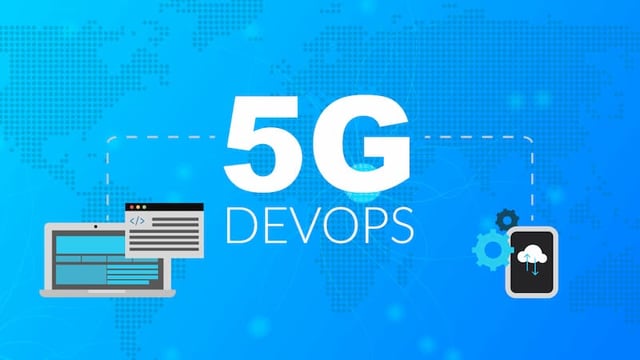Communication Service Providers (CSP) and telecom vendors have a lot to gain from adopting DevOps practices in the era of 5G.
5G presents an industrial revolution
5G networks are heralding the fourth industrial revolution with use cases spanning from cloud gaming to AR/VR applications, from autonomous vehicles to smart cities. This presents a huge leap in network technology and applications for the telecommunications (telco) industry.
5G migrations should come paired with shifts to agile software development and agile service provision, to take advantage of software-defined networks, for example. DevOps has a lot to offer telcos here.
DevOps in the era of 5G
5G brings with it a number of operational challenges and opportunities to save costs which can be addressed by DevOps. The cultural, process, and automation improvements to software delivery presented by DevOps can improve time to market and customer satisfaction for telco industry players in the following ways.
- Managed DevOps platforms and DevOps tooling can create the automation and ecosystem to support telco networks.
- Practices to improve processes and align organizational structures, e.g. value stream design or automated test/ QA strategies, can provide cost savings and increase innovation.
- Adopting DevOps culture can lead to improved collaboration between development (vendor) and operations (CSP).
- DevOps practices can define and validate new services to enable higher value capture and make the most of significant investments.
Let’s delve deeper into why DevOps is at the heart of 5G transformation.
DevOps facilitates edge computing
5G will mean that edge computing and hybrid clouds will increase in telco networks. Edge computing brings content or data processing capability closer to the end user or data source so that an instantaneous, real-time response can be delivered.
Virtualization makes this possible, and virtualization is a practice which sits in the domain of DevOps. By adopting cloud native architecture, telcos can successfully break down the purpose-built hardware and software based monolithic solutions into real microservices.
These microservices then move towards the edge of the network to provide the required latency and throughput.
It’s commonly said that new applications, new radio access, and the increased demand for connectivity and speed will result in a factor of 100 growth in network density and a factor of 100 improvement in network performance.
Automation improves agility and time to market
Traditionally, in the telco industry it can take up to 1-2 years for new software to go live. In the world of 5G, this is no longer acceptable as the pace of new service introduction is primarily defined by over the top (OTT) service providers like Netflix and Hulu.
Today, the telco industry must significantly shorten its time to market in order to be considered as viable infrastructure providers for these OTTs and unlock enterprise customers.
Automation and continuous deployment, two bread and butter practices of DevOps, do just that. What’s more, automation also makes collaboration between vendors on issues such as QA easier. The efficient sharing of information and instant feedback from CSP (Ops) to vendor (Dev) can be enabled and supported with automation.
The sheer scale of the 5G network and its vast number of applications must be supported by end-to-end automation, including delivery, deployment, acceptance and operations.
DevOps processes fuel innovation
Of course, this automation have to be backed by appropriate processes. As Rod Michael said “If you automate mess, you get an automated mess”.
Currently, the processes of CSPs are set out to control risk and cost, and with this they are inhibiting innovation and experimentation, which actually adds more cost and risk to any new software roll-out.
In a recent BearingPoint//Beyond survey, one of the identified critical improvements for CSPs was to change their existing bureaucratic processes. 39% of enterprises pointed out challenges in CSPs’ current mode of operation and only 26% see CSPs as key partners for innovative information and communication technology services.
The process improvements of DevOps, which remove waste from the value chain thereby getting value to customers faster, have a lot to offer here.
DevOps tools and pipelines will benefit CSPs
With the onset of 5G, the technology that’s needed has become significantly more diverse. The current ecosystem of CSPs, including their software assembly line, is not necessarily fit for this purpose. Only 12% of CSPs claim that they already have the appropriate ecosystem in place and 54% admit that their current ecosystem is not fit for seamless orchestration with partners.
In addition to CSPs, telecom vendors are also facing a similar challenge. A vendor’s software development and delivery methods and their DevOps pipeline should join and efficiently supply this new CSP pipeline. A joint vendor-CSP DevOps pipeline should eventually incorporate CRM, procurement, finance, controlling and other business functions.
DevOps tooling and DevOps Platforms have a lot to offer CSPs when it comes to their technology stack.
Learning the lessons of 4G: business models must evolve
Currently, CSPs face a number of organizational challenges including a lack of technology knowledge throughout different organizational groups. All these challenges manifest in slow service introduction and missed business opportunities.
As Nicki Palmer, SVP of technology at Verizon, said in an interview with SDxCentral. “We learned a few things with 4G... there are a lot of others that use this fantastic network that we developed to develop their own business models and innovate on top of it. We are determined not to make that mistake again and to be better at it.”
Ultimately, business innovation is what CSPs need to strive for when it comes to 5G. The aim is to become more than a simple bitpipe. By moving up in the value stream, the telco industry can address the enterprise market properly and design services as the OTTs like Netflix are doing it.
Published: Nov 20, 2019
Updated: Apr 30, 2021



